JTTP 2025
Results of the 26th Jeu de temps / Times Play
Artists and Submissions | Events | Awards | Jury
Recent works by young and/or emerging electroacoustic artists from or living in Canada are celebrated in JTTP 2025, the 26th edition of Jeu de temps / Times Play coordinated by the Canadian Electroacoustic Community (CEC).
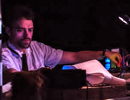

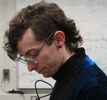
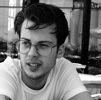


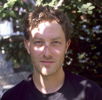


Jeu de temps / Times Play (JTTP) is an annual project aimed at supporting and encouraging new works by young and/or emerging electroacoustic artists from or living in Canada. A diverse international jury adjudicates and selects the prize-winning works and award recipients. For each edition of the project, a series of events are coordinated featuring selected JTTP works, including radio broadcasts of JTTP submissions and performances of the selected works in concert by our Project Partners in Canada and abroad. Cash and prizes are awarded to the creators of the top-placing works and the thematic award recipients, and submissions are featured on these pages and in Sonus, the CEC’s online Jukebox for electroacoustic and related practices.
Prizewinners and Thematic Award Recipients
It is with great pleasure that the CEC announces the results of JTTP 2025. Join us in celebrating the following electroacoustic artists, whose works have been selected by an international jury for JTTP 2025 Prizes and Thematic Awards. Listen to and view their works on this page while you read their biographies and programme notes.
JTTP Prizes
- Emanuel Brie, Antonin Gougeon-Moisan -- Quand on donne aux choses un sens, rien ne sert de chercher la direction (Video - 2024 / 24:17)
- Vivian Li -- Sonic Memories of Fleeting Times | 流声逝忆 (2025 / 15:00)
- [ex æquo] Michele Selvaggi -- Quondam, Apparatus (2023 / 16:30)
- [ex æquo] Justin Tatone -- XIV. Concord 1 - 5 With Concordia Laptop Orchestra (Stereo) (2025 / 22:15)
- [ex æquo] James Player -- Camino de Santiago (2025 / 10:44)
Thematic Award Recipients
- Hildegard Westerkamp Award for soundscape and sound installation
James Player -- Camino de Santiago (2025 / 10:44) - Micheline Coulombe Saint-Marcoux Award for self-identified female or non-binary electroacoustic artists
Michele Selvaggi -- Quondam, Apparatus (2023 / 16:30) - Jean Piché Award for videomusic, new media and creative coding
Gabriel Geneau -- Ecdysis (Video - 2023 / 7:28) - Martin Gotfrit and Martin Bartlett Award for live electroacoustic practices
Emanuel Brie, Antonin Gougeon-Moisan -- Quand on donne aux choses un sens, rien ne sert de chercher la direction (Video - 2024 / 24:17) - Barry Truax Award for environmental or ecological audio practices
Graeme Dyck -- Frost Worlds: Micro-Geographies of the Anthropocene (2025 / 11:11) - jef chippewa Award for Indigenous cultural background
Cordell Collett -- Nøkken (2025 / 2:44) - Yves Gigon Award for the most outrageous electroacoustic work
Emanuel Brie, Antonin Gougeon-Moisan -- Quand on donne aux choses un sens, rien ne sert de chercher la direction (Video - 2024 / 24:17)
Biographies and Programme Notes
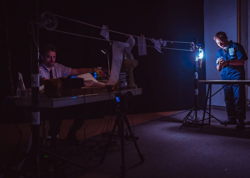
Emanuel BRIE, Antonin GOUGEON-MOISAN
JTTP 2025 First Prize winners, Martin Gotfrit and Martin Bartlett Award for live electroacoustic practices, Yves Gigon Award for the most outrageous electroacoustic work
Emanuel Brie is an electronic music artist based in Montreal. He combines synthetic and acoustic sonorities, soundscapes and electroacoustics, exploring how the matter around us, current and decayed, can become an instrument and then create emotion through noise, which in turn becomes music. The piano remains the common thread running through his musical evolution. Mainly inspired by the complexity and organized anarchy of nature, he constructs a multi-layered sound universe where the sound of the acoustic instrument adds to electroacoustic textures. In addition to composing for various audiovisual projects, he is completing a bachelor's degree in digital music at the Université de Montréal. During his studies, he explored feedback and turned mainly to sound installation, with a focus on the concept of the musical ecosystem. His works are an ode to the random, the imperfect and the singularity of a sound moment where the unexpected reveals a human imprint.
Antonin Gougeon-Moisan is a 31-year-old composer, sound and video designer from Montreal. After studying creation and production at the National Theatre School of Canada, he joined Studio Mirari as a multimedia producer. For six years, he participated in the creation of some one hundred live arts projects and created installations presented in several countries. A Master's student in Composition and Sound Creation, his work as an artist-researcher, supported by the FRQ, explores the musicality of the spoken voice, the transmission of knowledge in documentary sound art, and the links between memory and sound. Through his creations, he weaves a sensitive dialogue between words, images and sound textures, giving rise to immersive, evocative works.
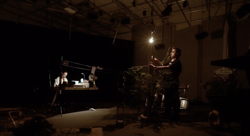

Quand on donne aux choses un sens, rien ne sert de chercher la direction (2024 / 24:17)
Duration: 24:00, in continuous loop, 2h30 per day, 3 days (total of 7h30).
Quand on donne aux choses un sens, rien ne sert de chercher la direction is a performative installation inspired by capitalist modes of production, approached from a critical standpoint. Two workers, dressed in work overalls and surrounded by a collection of worn-out objects, work on something in front of us. They hack and saw a balsam fir trunk, lift rocks, transfer sand, transcribe strings of words and poems by hand and on a typewriter—but what are they really doing? Do they themselves know what they’re creating, or are they simply following the clock ticking at the center of the space?
In this piece, the sounds of materials and actions reveal a musicality where the real sound of matter blends with an accompanying musical arrangement, resulting in an incessant, iterative hum—the sound of a machine that doesn’t know how to shut down. In a workday where the punch clock promises the next break, the cycle of labor itself never stops.
The daily routine of a worker—manual or clerical—is made up of countless standardized gestures. But can one still exist uniquely, simply be? Through repetitive gestures and ambiguous actions that may leave one puzzled, these two anonymous workers live out, before us, the banal spectacle of modern society. They work, earn, eat peanuts, and start again—until the clock rings—without asking questions.
This installation-performance finds meaning in its duration and its iterative, unending nature. It invites visitors to observe the construction unfolding within a fragmented scenography at different moments of the day, over the course of several days. Within this apparent formal repetition emerges a parallel commentary on utility, compensation, materiality, and the exhaustion of meaning.

Cordell COLLETT
Recipient of the jef chippewa Award for Indigenous cultural background
Cordell Collett is an Edmonton-based composer, producer, audio engineer, and DJ whose genre-defying work bridges rap, electronic music, and beyond. His productions, marked by a distinctive sonic signature, have collaborated with diverse artists, showcasing his versatility and innovative approach to sound. Currently studying at the University of Lethbridge, Cordell explores the intersection of acoustics, emotion, and auditory perception, deepening his ability to translate feeling into music. Fueled by this expanding knowledge, he continues to push creative boundaries, crafting immersive auditory experiences that resonate with listeners.
Nøkken (2:44 / 2025)
Nøkken embodies the delicate equilibrium of existence-light and shadow, joy and sorrow, and all the nuances in between. Nature, in its raw and unfiltered truth, mirrors this duality most profoundly. This piece serves as a reflection on reconnection and the timeless dance of opposing forces where humanity has grown distant from the divine and the natural.
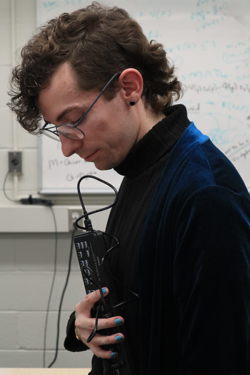
Graeme DYCK
Recipient of the Barry Truax Award for environmental or ecological audio practices
Graeme Dyck (they/he) is a sound artist / writer / researcher from Saskatchewan whose meandering practice often centres questions of ecology, materiality, and our relationships with the nonhuman. They have published work combining music and mathematics, won competitions for hybrid fiction and nonfiction, performed experimental music and live electronics in a variety of settings, and composed for festivals in Saskatoon and Birmingham. Graeme has a BMus, a BSc in Mathematics, and a certificate in jazz from the University of Saskatchewan, as well as an MA in electroacoustic composition and sonic art from the University of Birmingham, UK.
Frost Worlds: Micro-Geographies of the Anthropocene (11:11 / 2025)
Frost Worlds is a micro-geographical study based on snow and ice contact microphone recordings made during winter in Saskatoon, when increasing climate change-induced volatility has meant rapid shifts in weather conditions, from sudden -40 C snaps to unseasonably warm periods and unusual precipitation. Heard up close, this volatility generates a swift succession of ice soundscapes that speak to both the injury humans do to our nonhuman neighbours and the imaginative potential of the ever-changing, ever-adapting micro-worlds around us: a bristling desert in an empty parking space, stratified ice and dirt migrating down a foot of gutter, precarious crystal pillars creaking in the shade of a pine, the heavy clatter of snowflakes on asphalt. Careful field recordings are combined with additional sound sources to explore the life of these tiny, vibrant worlds.
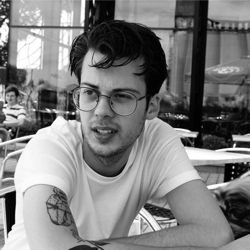
Gabriel GENEAU
Recipient of the Jean Piché Award for videomusic, new media and creative coding
Gabriel Geneau is an artist whose practice revolves around the encounter between sound, light and technology.
He creates works where music and the visual complement and nourish each other, offering unique sensory experiences.
Always on the lookout for new creative avenues, he integrates modern tools to enrich his artistic language, while remaining faithful to an intuitive, emotional approach.


Ecdysis (video — 7:28 / 2023)
Ecdysis is a videomusic that traces the path of inner transformation. Through a discreet yet inhabited struggle, a body seeks to free itself, until it reaches a tipping point. The film interweaves sensitive music, symbolic images and dynamic lighting effects, inviting the audience to plunge into the back-and-forth of an emotional moult.
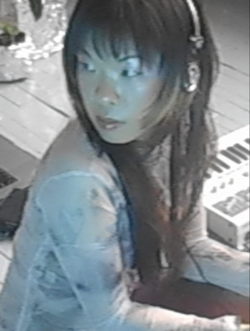
Vivian LI
JTTP 2025 Second Prize winner
A recent graduate of Université de Montréal, Vivian Li is a Tiohtià:ke/Montréal-based sound artist and composer whose work explores the interplay between memory, presence, and the ephemeral nature of lived experience. Through field recordings, radiophonic techniques, and spatial composition, they construct immersive sonic environments that drift between documentary and poetry—where laughter, rain, and half-heard conversations become resonant archives of lived experience.
She has performed and presented work at venues and festivals nationally and internationally, such as Karachi Biennale, Akousma (Montréal), MUTEK (Montréal), Pique (Ottawa), Sound Art Lab (Struer), Inkonst (Malmö), Eastern Bloc (Montréal), perte de signal (Montréal), Kwia (Berlin), and Fondation Phi x Nuit Blanche (Montréal).
Sonic Memories of Fleeting Times | 流声逝忆 (15:00 / 2025)
Sonic Memories of Fleeting Times | 流声逝忆 is a multiphonic, spatialized acousmatic piece that adopts a documentarist approach, exploring themes of intimacy, memory, and time through an aesthetic inspired by radio art. The work draws on autobiographical sound recordings — capturing moments at once mundane, intimate, and deeply personal — to create an immersive experience that transports the listener into another reality, another space-time.
*
A collection of lived experiences—
laughter, rain, eavesdropped conversations—
preciously fading, as they form.
To remember is to listen closely,
before they recede into the realm of memories.
~ ~ ~
“The curated recording is a hedge against mortality, the fragility of memory, and the ever-receding substance of history.” — Jonathan Sterne
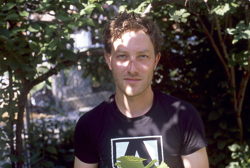
James PLAYER
JTTP 2025 Third Prize winner [ex æquo] and recipient of the Hildegard Westerkamp Award for soundscape and sound installation
James Player is a composer and musician based in Tio’tia:ke / Montréal. His creative practice spans multichannel composition, sound for video art, and durational live performance. While much of his recent work explores immersive spatial audio and soundscape composition, he remains rooted in his background as a guitarist, with a particular interest in free-form improvisation. He is currently finishing a degree in Electroacoustic Studies at Concordia University.
Camino de Santiago (10:39 / 2025)
Camino de Santiago is an 8-channel soundscape composition created from field recordings gathered while walking the Camino Portugués from Porto to Santiago de Compostela. The work is both a sonic journal and a meditation on movement, memory, and shared experience, exploring the interplay between physical space and inner space, presence and reflection.
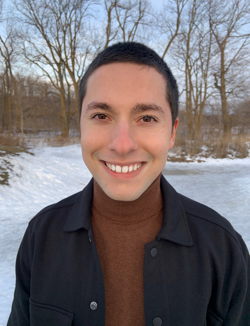
Michele SELVAGGI
JTTP 2025 Third Prize winner [ex æquo] and recipient of the Micheline Coulombe Saint-Marcoux Award for self-identified female or non-binary electroacoustic artists
Three-time SOCAN Composer Award Winning composer-performer Michele Selvaggi hails from the heart of downtown Toronto with strong Southern Italian roots and is currently based in both Toronto/Basel as a recent postgraduate. Concerned deeply with the physiological and perceptual experience of music, notably driven by their own existential confrontation with time’s passage, Michele’s experimental work is intensely coloured by influences from their earlier engagement in the natural sciences, resulting in noisy sonic topographies and detailed electroacoustic environments that are often shaded by their daily life living with demanding anxiety and OCD. Just intonation, feedback systems, and soundscape are but a few ongoing fascinations that unusually tinge their approach to sound.
Michele has been the recipient of over 20 awards and prizes including SOCAN Foundation Composer Awards in both Chamber Music and Electroacoustic Music, the 2025 winner of the Eduard Brunner Composition Prize at the Musik-Akademie Basel, as well as the Residency Prix CIME 2021. Their music has been included in the 2024 Canadian Section's submission to ISCM World Music Days, shortlisted for a 2022 Red Jasper Award, and led to nomination for a 2021 Rhodes Scholarship. In their most recent work, Michele has developed research that explores what they coin as “sonic entropy”, culminating in a prize-winning thesis on Entropic Drift at the Musik-Akademie Basel, which strove to unify the realms of arts and natural sciences by elaborating on their own scientifically-informed style. They are currently completing a larger series of electroacoustic pieces commissioned by Basel-based performers, funded by the Nicati - de Luze Foundation.
Quondam, Apparatus (16:30 / 2023)
Quondam, Apparatus was written for the [*removed for anonymity*] in collaboration with the Museum Tinguely. The conceptualization of this work emerged as both a continuation of my exploration into the concept of sonic entropy — a direct perpetuation of a series of works I have been creating for the past year — as well as a newfound investigation into acoustic recreations of real world environments; in this special case, I was seeking to recreate the kinetic machines of Jean Tinguely. Before beginning with the piece, I was given various recorded samples of machines, courtesy of the Museum Tinguely, each with their own individual character. I ordered these recordings in space based on their entropic relation to one another — taking into account the spectral content, sonic structure, and complexity of each entity — making, in essence, a machinic web through which the work was to travel.
The machines exist as singular beings in the museum itself, intended to be listened to individually and in succession; I wanted to take each entity out of context temporally and in the material sense, placing each within a larger, saturated conglomerate that growed, stretched, and evolved in complexity over time. Often, the inner movements of the machines are explored in detail, represented by instruments, or revealed through acoustic filtering. Seven transducers attached to different portions of the piano and to different percussion instruments allow for only certain components of the machines to enter the ensemble space; this form of acoustic filtering allows each machine to be transformed by the instrument itself, where it can then be doubly re-interpreted by the live instruments and objects. In addition, a live Tinguely Machine becomes its own player within the sonic scheme, working in tandem with the existing ensemble/electronics cloud — already fluttering and undulating with mechanical micro-movements — to create a supposed hyper-machine. The idea of gradual transformation in this work mirrors the ongoing conversation regarding how certain mechanical technology has changed, holds up today, and how such will change in the near future as further developments are made in the field of mechanization and industrialization.
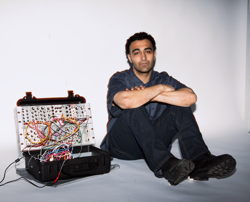
Justin TATONE
JTTP 2025 Third Prize winner [ex æquo]
TATO (b. Justin Tatone) is a Canadian Artist and composer who examines how technology interprets, distorts, and abstracts nature. His work bridges disciplines while maintaining a consistent focus on how control, decay, and illusion are at the overlap of the ecological metaphor and nonviolent disruption. Since designing his Eurorack modular synthesizer system in 2022, TATO has engaged with sound on a deeply structural level, combining techniques like generative algorithms in digital code‑based synthesizers and real‑time improvisation within an analog synthesizer patch. A graduate of Concordia University’s Electroacoustic Studies program, TATO has also received the Hugh and Trudi Le Caine Award in Electroacoustics (2024), the Alain Thibault Award in Electroacoustics (2024), and the Robert Daniel Ball Memorial Award in Music (2025) all at the age of 21. TATO has composed for live ensembles, including the Concordia Laptop Orchestra, and worked internationally as a composer for film and commercial advertisements. In 2025, he undertook a self‑directed global study of contemporary art, visiting major institutions across Europe, South America, and Southeast Asia. His practice expanded into installation, sculpture, and visual art after his time as a studio assistant and mentee to artist‑composer Adam Basanta, culminating at the 23rd International Image Festival in Manizales, Colombia where TATO presented digital paintings based on his compositional principles of feedback and biomimicry.
XIV. Concord 1 - 5 With Concordia Laptop Orchestra (Stereo) (22:15 / 2025)
Concord is an exploration of coexistence: conceptually, sonically, and spatially. The composition investigates how divergent sonic elements can share space without collapsing into sameness, inviting the listener to engage with difference not as conflict, but as layered presence. The concept of coexistence is woven into every dimension of the piece: extrinsically, through spatialization (diffusion), cultural context, and semantic meaning; intrinsically, through the compositional elements themselves: tones, rhythms, phrases, and gestures that reflect coexistence. The field recordings function not only as sound material but also as semantic anchors. Concord is overtly political. The inclusion and transformation of protest sounds situate the piece within a discourse of civil disobedience and sonic disruption. Concord expresses its commentary not through direct statement, but through form: through the coexistence of materials and perspectives that might otherwise seem incompatible; disgruntled students and their institution, a sine tone and its slightly detuned double, all on the same path towards a concord, or a consonance, much like the first and final gestures of the piece. Ultimately, Concord is a space where conflict and harmony are not opposites, but cohabitants. It is a work about deep listening: to protest, to transformation, to tension, and to the quiet possibilities of nonviolence. Coexistence, here, is not about resolution, but about holding space for contradiction, for disruption, and for the uncertain beauty that emerges when things are allowed to be together at the same time, not killing each other.
Jury
This year’s international jury was comprised of 8 individuals with a variety of artistic backgrounds, experiences and interests.
Kristi Allik (Kingston, ON)
Nicolas Bourgeois (Montréal, QC)
Andrea-Jane Cornell (Montréal, QC)
Ana Dall'Ara-Majek (Montréal, QC)
Brian Garbet (Saskatoon, SK)
Vanessa Massera (Montréal, QC)
James O'Callaghan (Berlin, DE)
Dominic Sambucco (Padru, IT)

Social top